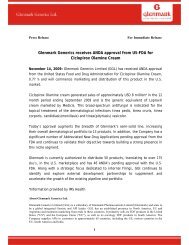Download - Glenmark
Download - Glenmark
Download - Glenmark
Create successful ePaper yourself
Turn your PDF publications into a flip-book with our unique Google optimized e-Paper software.
Financial liabilities are recognised when the Group becomes a party to the contractual agreements of the<br />
instrument. All interest related charges is recognised as an expense in “finance cost” in the income statement.<br />
Trade payables are recognised initially at their fair value and subsequently measured at amortised cost less<br />
settlement payments.<br />
Dividend distributions to shareholders are included in ‘other current liabilities’ when the dividends are approved<br />
by the shareholders’ meeting.<br />
3.14 INVENTORIES<br />
Inventories of finished goods, consumable store and spares are valued at cost or net realisable value, whichever<br />
is lower. Cost of raw materials and packing materials is ascertained on a weighted average cost basis. Cost<br />
of work-in-process and finished goods include the cost of materials consumed, labour and manufacturing<br />
overheads. Excise and customs duty accrued on production or import of goods, as applicable, is included in the<br />
valuation of inventories.<br />
Net realisable value is the estimated selling price in the ordinary course of business, less the estimated costs of<br />
completion and selling expenses.<br />
The factors that the Group considers in determining the allowance for slow moving, obsolete and other<br />
non-saleable inventory includes estimated shelf life, planned product discontinuances, price changes, ageing of<br />
inventory and introduction of competitive new products, to the extent each of these factors impact the Group’s<br />
business and markets. The Group considers all these factors and adjusts the inventory provision to reflect its<br />
actual experience on a periodic basis.<br />
3.15 ACCOUNTING FOR INCOME TAXES<br />
Income tax expense consists of current and deferred tax. Income tax expense is recognised in income statement<br />
except to the extent that it relates to items recognised in Other Comprehensive Income, in which case it is<br />
recognised in Other Comprehensive Income. Current tax is the expected tax payable on the taxable income<br />
for the year, using tax rates enacted or substantively enacted at the reporting date, and any adjustment to tax<br />
payable in respect of previous years.<br />
Deferred tax is recognised using the statement of financial position method, providing for temporary differences<br />
between the carrying amounts of assets and liabilities for financial reporting purposes and the amounts used for<br />
taxation purposes.<br />
Deferred tax is not recognised for the following temporary differences:<br />
- The initial recognition of assets or liabilities in a transaction that is not a business combination and that<br />
affects neither accounting nor taxable profit, and<br />
- Differences relating to investments in subsidiaries and jointly controlled entities to the extent that it is<br />
probable that they will not reverse in the foreseeable future.<br />
In addition, deferred tax is not recognised for taxable temporary differences arising upon the initial recognition of<br />
goodwill. Deferred tax is measured at the tax rates that are expected to be applied to the temporary differences<br />
when they reverse, based on the laws that have been enacted or substantively enacted by the reporting date.<br />
Deferred tax assets and liabilities are offset if there is a legally enforceable right to offset current tax liabilities<br />
and assets, and they relate to income taxes levied by the same tax authority on the same taxable entity, or on<br />
different tax entities, but they intend to settle current tax liabilities and assets on a net basis or their tax assets<br />
and liabilities will be realised simultaneously.<br />
A deferred tax asset is recognised to the extent that it is probable that future taxable profits will be available<br />
against which the temporary difference can be utilised. Deferred tax assets are reviewed at each reporting date<br />
and are reduced to the extent that it is no longer probable that the related tax benefit will be realised.<br />
3.16 LEASING ACTIVITIES<br />
At the inception of a lease, the lease arrangement is classified as either a finance lease or an operating lease,<br />
based on the substance of the lease arrangement.<br />
Finance leases<br />
A finance lease is recognised as an asset and a liability at the commencement of the lease, at the lower of the<br />
fair value of the asset or the present value of the minimum lease payments. Initial direct costs, if any, are also<br />
capitalised and, subsequent to initial recognition, the asset is accounted for in accordance with the accounting<br />
policy applicable to that asset. Minimum lease payments made under finance leases are apportioned between<br />
the finance expense and the reduction of the outstanding liability. The finance expense is allocated to each period<br />
during the lease term so as to produce a constant periodic rate of interest on the remaining balance of the liability.<br />
Operating leases<br />
Other leases are operating leases, and the leased assets are not recognised on the Company’s balance sheet.<br />
Payments made under operating leases are recognised in income statement on a straight-line basis over the<br />
term of the lease.<br />
Annual Report 2010-2011 89



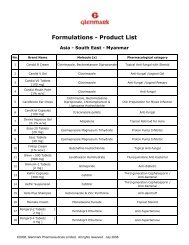


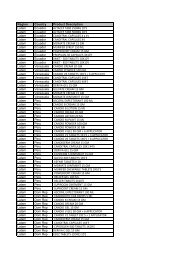
![Formulations [India] â Product List - Glenmark](https://img.yumpu.com/46601329/1/190x245/formulations-india-a-product-list-glenmark.jpg?quality=85)
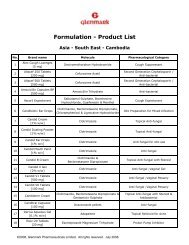
![Formulation [India] â Product List - Glenmark](https://img.yumpu.com/44013338/1/190x245/formulation-india-a-product-list-glenmark.jpg?quality=85)


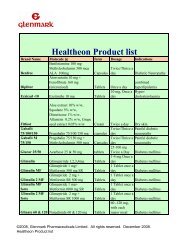
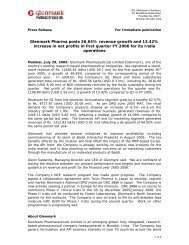
![Formulations [India] â Product List - Glenmark](https://img.yumpu.com/35994839/1/190x245/formulations-india-a-product-list-glenmark.jpg?quality=85)
